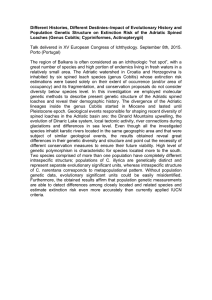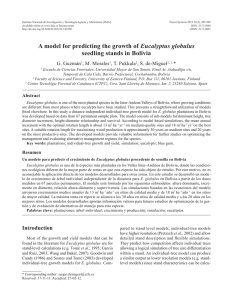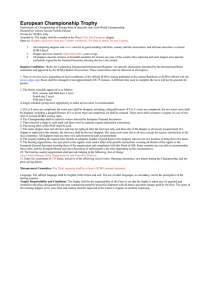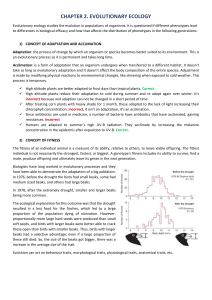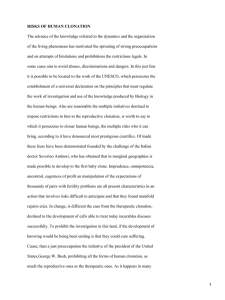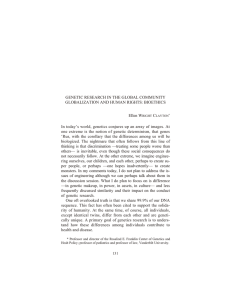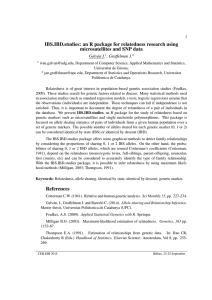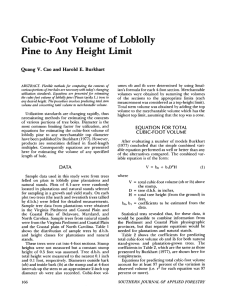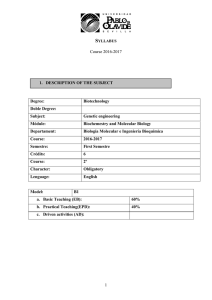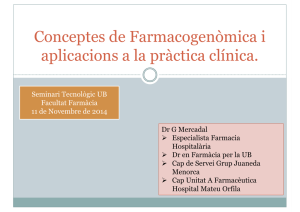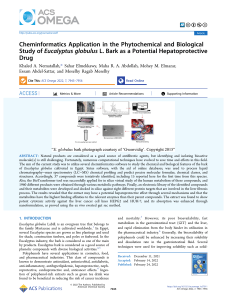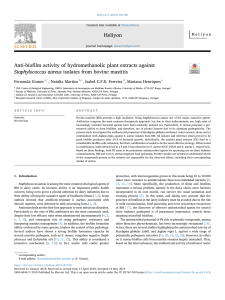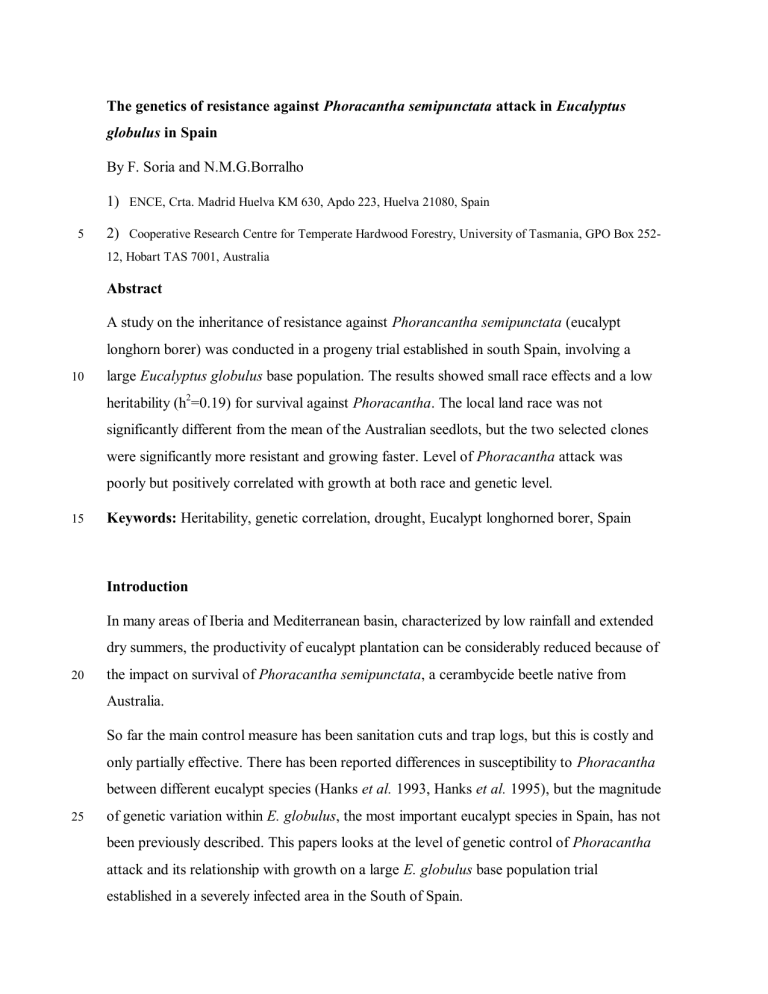
The genetics of resistance against Phoracantha semipunctata attack in Eucalyptus globulus in Spain By F. Soria and N.M.G.Borralho 1) ENCE, Crta. Madrid Huelva KM 630, Apdo 223, Huelva 21080, Spain 5 2) Cooperative Research Centre for Temperate Hardwood Forestry, University of Tasmania, GPO Box 25212, Hobart TAS 7001, Australia Abstract A study on the inheritance of resistance against Phorancantha semipunctata (eucalypt longhorn borer) was conducted in a progeny trial established in south Spain, involving a 10 large Eucalyptus globulus base population. The results showed small race effects and a low heritability (h2=0.19) for survival against Phoracantha. The local land race was not significantly different from the mean of the Australian seedlots, but the two selected clones were significantly more resistant and growing faster. Level of Phoracantha attack was poorly but positively correlated with growth at both race and genetic level. 15 Keywords: Heritability, genetic correlation, drought, Eucalypt longhorned borer, Spain Introduction In many areas of Iberia and Mediterranean basin, characterized by low rainfall and extended dry summers, the productivity of eucalypt plantation can be considerably reduced because of 20 the impact on survival of Phoracantha semipunctata, a cerambycide beetle native from Australia. So far the main control measure has been sanitation cuts and trap logs, but this is costly and only partially effective. There has been reported differences in susceptibility to Phoracantha between different eucalypt species (Hanks et al. 1993, Hanks et al. 1995), but the magnitude 25 of genetic variation within E. globulus, the most important eucalypt species in Spain, has not been previously described. This papers looks at the level of genetic control of Phoracantha attack and its relationship with growth on a large E. globulus base population trial established in a severely infected area in the South of Spain. Material and Methods Genetic material The families used in this study were obtained from a range-wide collection of 256 openpollinated families covering the entire natural range of Eucalyptus globulus subsp. globulus 5 in Australia (collection details are published in [Jordan, 1994 #71]). Cuttings of two plustrees from ENCE breeding program, and one commercial seedlot were also included in the trial. The plus-trees have been selected on the basis of their superior phenotype for growth and health, in highly affected areas in the region. Trial site and design 10 The trial is located in the SW of Spain, in the province of Andaluzia, near Huelva (lat 3734’N; long 650’W; alt 70m). Climatic conditions are typically Mediterranean with around 500 mm annual rainfall, a mean annual temperature of 17.5C, and less than 10 days of frost per year. However, the climatic conditions prevalent during most of the trial were generally drier than average: the total rainfall in 1992, when the trial was 2 years old, was a 15 record low 250 mm. Soil is a distric cambisoil, with a hard-pan horizon at around 50 cm deep. The soil was cultivated prior to planting using a mould-board plough to 60 cm. Plants were established in a 3 x 3.5m spacing, and fertilized at planting. In the commercial seedlings, a slow release fertiliser was also applied to the paper-pot medium. Weeds were controlled one year after planting by discing. 20 Families were grouped in five sub-lines, according to Table 1. Families were then randomized within each sub-line, in three non-contiguous two tree plots per block. There were 4 blocks per subline. The two clones, propagated from stem cuttings, and one commercial seedlot were included in all blocks across the five sublines. [Jordan, 1994 #71] and [Dutkowski, 1997 #81] classification was used as a basis to group the different families 25 into native races. The two clones and the commercial seedlot were grouped in a local landrace. Table 1. Distribution of races across the five sublines (SL1 to SL5), and total number of families and trees per race in the trial. Measurements 5 The measurements include five year old diameter, height and presence or absence of Phoracantha. Tree health was assessed according to a Status and Cause code, as detailed in Table 2. Trees which were which have been attacked or killed by Phoracantha or by fungus (Status 02 and 03 and Cause 04, 08 and 09) were scored as 0, whereas those which showed no sign of attack were given a score of 1. Although fungus and Phoracantha attack was 10 scored separately, in practice the two effects seem to be associated or difficult to separate. Trees dead or affected by other causes (e.g. frost, wind, animals), were excluded from the analysis. Subline Race 0. Land race + clones 1. Lavers Hill 2. OtwayRangesW 3. OtwayRangesE 4. Strzelecki 6. S.Gippsland 7. FlindersIs 8. Cape Barren 9. Clark Is. 10. St. Helens 11. NE Tasmania 13. Tasman Peninsula 15. SE Tasmania 16. Dromedary 17. Jericho 18. South Tasmania 19. Dover 22. West Tasmania 23. King Is. 15 1 X X X 2 X 3 X 4 X 5 X X X X X X X X X X X X X X X X X X X X X X No. Fam 3 5 41 28 32 1 35 28 3 3 5 5 26 4 5 9 4 10 7 No. Trees 351 68 629 408 568 10 510 451 45 58 90 51 503 50 94 129 46 132 118 Table 2. Classification of status and cause of damage in the trial. Status 01 02 03 04 99 Broken top Sick Dead Leaning None of the above Cause of damage 01 02 03 04 05 06 07 08 09 10 99 Water runnoff Waterlogging Frost Drought (in association with Phoracantha) Cattle Rats Wind Phoracantha Fungus Machines None of the above 5 10 15 20 Statistical analysis Estimates of variance and covariance for height, diameter and Phoracantha were obtained by Restricted Maximum Likelihood (REML), using an Average Information algorithm 25 ([Gilmour, 1995 #15]). For estimation of variance components, the commercial controls and clones were removed from the analysis and analysis was carried out within a set, based on the following linear model: y = u + set + rep/set + race + fam + plot + error where y is the vector of observations for height, diameter and attack by Phoracantha, set is 30 the effect due to sets (fixed), rep the effects due to blocks (fixed), fam is the effect due to open pollinated families (random), race is the effect due to races (random) and plot is the effects due to plots (random). Standard errors for variance ratios were obtained directly from the inverse of the mixed model equations. Additive variance was assumed to be equal to 2.5 the family variance. Given 0/1 nature of the survival trait, heritability and phenotypic correlation estimates for attack by Phoracantha were in a binomial scale and were converted to a liability scale according to ([Olausson, 1975 #72]). The data used in the estimation of random (BLUP) and fixed effects (BLUE) included the Australian open pollinated families, and all unimproved seedlings and the two clones, 5 assumed unrelated and coming from the same local land race. The model differed slightly in that no account was made of the set effects: y = u + rep + race + fam + plot + error. The two clones and the unimproved seedlot were present in all reps and sets, and are expected to provide the necessary links between sublines, hence allowing the analysis to 10 account for genetic differences between families across sublines. Results and Discussion The trial had poor growth and survival. Around 10% of the trees were dead or badly affected by frost and of the remaining trees, used in the analysis, 59% were dead or severely affected by Phoracantha. Such levels are not uncommon in many dry areas of Spain and 15 Portugal ([Lencart e Silva, 1994 #64]), particularly following a number of dry years. The mortality due to Phoracantha varied across the trial, with mean block incidences ranging between 42 and 82%. Height at five years was 5.7 1.4 m, and diameter was 6.2 1.9 cm. This is lower than reported growth rates in progeny trials of similar origin and age in higher rainfall areas in central and south of Portugal ([Borralho, 1992 #14], [Araújo, 1996 #23]), 20 and North of Spain (Soria et al. 1997), and amongst the lowest site indices from forest inventory data ([Tomé, 1994 #73]). It reflects the particularly poor years experienced by the this trial prior to the 5 year old assessment. Race effects The means for diameter, height and level of Phoracantha incidence are listed in Table 3. The 25 local land race grew marginally better (2%) than the mean of all Australian races, excluding Wilson Promontory (Table 2). The best native races for growth were St. Helens (Tasmania), Strzelecki and West Otway Ranges (Victoria) and South Tasmania, with growth rates significantly better (at 1% level) to the unimproved land race. A few native races were also more resistant than the unimproved land race to Phoracantha. The best races were Cape Barren Island and Flinder Island from the Furneaux group of islands in Bass Straight, with 45 and 50% incidence, respectively. King Island, NE Tasmania and West Coast Tasmania were the least resistant (around 75%). 5 Table 3. Least-square means for height, diameter and percentage of trees dead or seriously affected by Phoracantha at five years, for the Australian races, the unimproved land-race, the two clones from ENCE breeding program, and the best 5 families in the native collection for each trait. Race 0. Land race Clone A Clone B Commercial 1. Lavers Hill 2. OtwayRangesW 3. OtwayRangesE 4. Strzelecki 5. Wilsons Promontory 6. S.Gippsland 7. Flinders Island 8. Cape Barren 9. Clark Island 10. St. Helens 11. NE Tasmania 13. Tasman Peninsula 15. SE Tasmania 16. Mt. Dromedary 17. Jericho 18. South Tasmania 19. Dover 22. West Tasmania 23. King Island Best 5 Aust. Families Height m Diam cm Phor (%) 6.76 6.53 6.00 5.75 6.27 5.98 6.30 4.33 5.95 5.62 5.50 5.14 6.40 5.99 5.67 5.97 5.39 5.56 6.29 6.21 5.61 6.00 7.00 7.26 7.02 6.51 6.38 5.76 6.39 6.79 4.70 6.45 6.23 6.22 5.70 6.83 6.31 6.14 6.42 5.88 6.13 6.67 6.67 5.96 6.24 7.73 26 29 56 54 56 64 53 69 58 51 43 55 64 73 63 61 60 55 67 66 70 79 31 10 The two plus trees, which were selected on the basis of superior phenotype for growth and health in affected areas in South of Spain, were clearly above the trial mean for growth and resistance against Phoracantha. The clones grew on average 12% better for height and diameter, compared with unimproved seedlings and the mean of Australian races, and had a mean Phoracantha incidence of 28%, a substantial gain from the 56% observed in the seedlings. 5 Genetic parameters Variance components due to race, additive genetic and plot effects are listed in Table 4, for height, diameter and Phoracantha attack. Race effects account for 17% of the total variation in height, 9% in diameter and 4% in Phoracantha. Within-race heritability for height and diameter was 0.23 and 0.16 respectively, somewhat lower than previous 10 estimates from the same population in Australia ([MacDonald, 1997 #75]), but agreeing well with [Borralho, 1992 #37] and [Araújo, 1996 #23] results in Portugal and (Soria et al. 1997) in Spain. The results could suggest that growth in this type of environments may be less heritable than elsewhere, although the poor connectedness between the five sublines and the large block sizes may have also affected the accuracy of heritability estimates. The 15 heritability for Phoracantha attack, given in the underlying scale was low (h2L=0.19). To our knowledge, this is the first reported heritability estimate for Phoracantha resistance in eucalypts. Table 5. Variance components and heritability estimates, given on the underlying scale based 20 on an intraclass correlation amongst open pollinated sibs of 0.4. Variance components Trait Race Fam Plot Height 0.325 0.178 0.123 Diameter 0.320 0.230 0.200 Phoracantha 0.010 0.011 0.007 1 Heritability adjusted to the liability scale. Error 1.258 2.880 0.206 h2 (s.e.) 0.23 (0.056) 0.16 (0.049) 0.19 (0.022) 1 The genetic and race correlation amongst the three traits is listed in Table 5. Height and diameter were highly correlated at both genetic and race levels (r G=0.93 and rR=0.97). 25 Similar findings were reported for the subspecies in Portugal ([Borralho, 1992 #14]) and Australia ([Volker, 1990 #69], MacDonald et al. 1997). Genetic correlation between growth traits and Phoracantha was positive but low and, as expected, associated with large standard errors (rG = 0.30 0.17 and 0.32 0.20, for height and diameter respectively). Table 5. Genetic (above diagonal) and race correlation (below diagonal) for height, diameter 5 and Phoracantha attack. Height Height Diameter Phoracantha 0.96 0.03 -0.02 0.36 Diameter Phoracantha 0.93 0.03 0.30 0.17 0.32 0.20 0.19 0.37 Corresponding race correlations for height and diameter were less interpretable (r R=-0.02 and 0.19, respectively; Table 5), but suggest a near zero genetic relationship between growth rate and resistance against Phoracantha at the race level. 10 There is some chance that the correlations presented here may be affected by unbalance in the data. The majority of the tree scored as affected by Phoracantha had no assessment for growth. Of the 4236 trees included in the analysis, 2024 were measured for growth but only 202 of them were also considered affected by Phoracantha. Therefore, most trees affected did not have any growth measurement. If the two traits are genetically correlated, there is an 15 indirect selection for growth due to the mortality caused by Phoracantha. In theory, this problem is expected to reduce in absolute terms the estimated covariance between the two traits ([Villanueva, 1990 #77]), so the magnitudes of the correlations reported here should be seen as an upper limit of the true estimates. In conclusion, correlations between growth and resistance against Phoracantha are likely to be low. 20 Implications for breeding The differences observed in resistance to Phoracantha between races and families have important implications for breeding decisions. Recently, [Chambers, 1997 #78] showed that with mortality reducing the stocking to 50% of its optimum level, as observed in our trial, survival becomes four times more important than growth of the survivors, when the 25 objective is to maximise gains in volume per hectare. In conditions were cause of death can be attributed to a specific cause, such as with Phoracantha here, selection criteria should therefore focus on improving the resistance against Phoracantha even if only modest gains are achieved in the growth rate of survivors. At the race level, Strzelecki and Otway Ranges (West) from Victoria seemed to have the best combination of growth and resistance against 5 Phoracantha. On the other extreme, West Tasmania and King Island had poor growth and were particularly susceptible to Phoracantha. These races are expected to be ill-adapted to Spanish conditions - the two are genetically close ([Jordan, 1994 #71]) and from the wettest range of E. globulus distribution. However, the NE Tasmania races, and particularly St. Helens, were highly susceptible to Phoracantha. This is a surprising result since NE 10 Tasmania has been amongst the fastest growing and more drought resistant races in Phoracantha-free conditions in Western Australia ([Kube, 1995 #70], [Dutkowski, 1995 #67]). St. Helens was also amongst the fastest growing race in our trial but its high susceptibility to Phoracantha attack makes it less attractive for future infusions. This suggests that resistance mechanisms against the insect may be distinct from those against 15 drought in the absence of the insect. The result, however, contradicts early findings by [Hanks, 1995 #79] which reported a strong correlation, albeit at the species level, between dry conditions in the seed source, and higher ex situ Phoracantha resistance characteristics. Despite the race differences, most of the genetic variation is found within a race. For example, selecting the 5 best Australian families on the basis of progeny information alone is 20 expected to reduce the incidence of Phoracantha from 58% as in the unimproved seedlings, to around 31%. Similar gains were found for the two clones used in the trial and previously selected for they superior growth, form and health in highly affected plantations. They were 15% better than average for growth and only 28% of the cuttings were damaged or killed by the insect. 25 Expected gains from family selection seem therefore to be of the same order of magnitude to those from mass selection and propagation. While mass selection is known to be clearly less accurate, it is also associated with much larger selection intensities. This is expected to be the case since the plus-trees were amongst the very few survivors in highly affected plantations. The result confirms the effectiveness of ENCE’s plus-tree selection and propagation program to improve growth and in particularly insect resistance under local conditions. Because of the binary nature of the trait, there is little chance of further improvements from within family selection. This would require, for example, having several ramets per clone and 5 select them on average incidence, or establish large family blocks in highly infected areas where incidence levels could approach a high selection intensity (of say 90%). These are important operational limitations when considering the selection against Phoracantha. Conclusions So far E. globulus programs have concentrated on volume per tree and, in some cases, 10 wood density ([Borralho, 1993 #34], [Greaves, 1997 #35]). However, given the large impact of Phoracantha in the mortality of plantations in dry areas in the South of Spain, breeding programs should consider including Phoracantha damage as a major selection trait. According to our results, important gains in survival and growth of survivors have already been achieved from mass selection, but further improvements could be realised as a result of 15 moderate heritability and considerable genetic variation at the race and family levels. Unfortunately, resistance against Phoracantha seems to be poorly correlated with growth, so selection programs relying on growth alone are not expected to improve the resistance against the insect. Furthermore, one of the fast growing races was also amongst the most susceptible to the insect. 20 The relative importance of each trait in future selection decisions depends on the impact of Phoracantha across the whole plantation estate and the ability to carry out effective within family selection for Phoracantha, not the least to have progeny trials being established in highly affected areas. The results on heritability and genetic correlations with growth reported in this paper provide important basic information to model such decisions. 25
